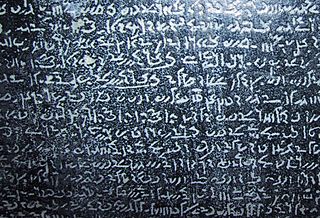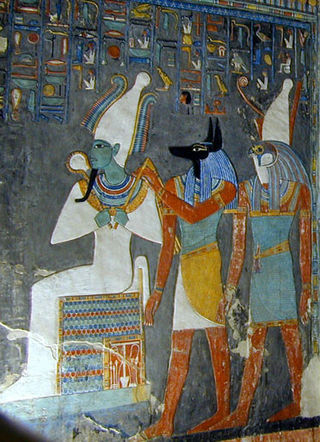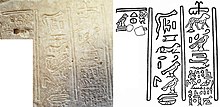Ancient Egyptian religion was a complex system of polytheistic beliefs and rituals that formed an integral part of ancient Egyptian culture. It centered on the Egyptians' interactions with many deities believed to be present and in control of the world. About 1500 deities are known. Rituals such as prayer and offerings were provided to the gods to gain their favor. Formal religious practice centered on the pharaohs, the rulers of Egypt, believed to possess divine powers by virtue of their positions. They acted as intermediaries between their people and the gods, and were obligated to sustain the gods through rituals and offerings so that they could maintain Ma'at, the order of the cosmos, and repel Isfet, which was chaos. The state dedicated enormous resources to religious rituals and to the construction of temples.

Osiris is the god of fertility, agriculture, the afterlife, the dead, resurrection, life, and vegetation in ancient Egyptian religion. He was classically depicted as a green-skinned deity with a pharaoh's beard, partially mummy-wrapped at the legs, wearing a distinctive atef crown, and holding a symbolic crook and flail. He was one of the first to be associated with the mummy wrap. When his brother Set cut him up into pieces after killing him, Osiris' wife Isis found all the pieces and wrapped his body up, enabling him to return to life. Osiris was widely worshipped until the decline of ancient Egyptian religion during the rise of Christianity in the Roman Empire.

The Rosetta Stone is a stele of granodiorite inscribed with three versions of a decree issued in 196 BC during the Ptolemaic dynasty of Egypt, on behalf of King Ptolemy V Epiphanes. The top and middle texts are in Ancient Egyptian using hieroglyphic and Demotic scripts, respectively, while the bottom is in Ancient Greek. The decree has only minor differences across the three versions, making the Rosetta Stone key to deciphering the Egyptian scripts.

Isis was a major goddess in ancient Egyptian religion whose worship spread throughout the Greco-Roman world. Isis was first mentioned in the Old Kingdom as one of the main characters of the Osiris myth, in which she resurrects her slain brother and husband, the divine king Osiris, and produces and protects his heir, Horus. She was believed to help the dead enter the afterlife as she had helped Osiris, and she was considered the divine mother of the pharaoh, who was likened to Horus. Her maternal aid was invoked in healing spells to benefit ordinary people. Originally, she played a limited role in royal rituals and temple rites, although she was more prominent in funerary practices and magical texts. She was usually portrayed in art as a human woman wearing a throne-like hieroglyph on her head. During the New Kingdom, as she took on traits that originally belonged to Hathor, the preeminent goddess of earlier times, Isis was portrayed wearing Hathor's headdress: a sun disk between the horns of a cow.

Nephthys or Nebet-Het in ancient Egyptian was a goddess in ancient Egyptian religion. A member of the Great Ennead of Heliopolis in Egyptian mythology, she was a daughter of Nut and Geb. Nephthys was typically paired with her sister Isis in funerary rites because of their role as protectors of the mummy and the god Osiris and as the sister-wife of Set.

Roman Egypt was an imperial province of the Roman Empire from 30 BC to AD 641. The province encompassed most of modern-day Egypt except for the Sinai. It was bordered by the provinces of Crete and Cyrenaica to the west and Judaea, later Arabia Petraea, to the East.
The Philae temple complex is an island-based temple complex in the reservoir of the Aswan Low Dam, downstream of the Aswan Dam and Lake Nasser, Egypt.

Mandulis was a god of ancient Nubia also worshipped in Egypt. The name Mandulis is the Greek form of Merul or Melul, a non-Egyptian name. The centre of his cult was the Temple of Kalabsha at Talmis, but he also had a temple dedicated to him at Ajuala.

Demotic is the ancient Egyptian script derived from northern forms of hieratic used in the Nile Delta. The term was first used by the Greek historian Herodotus to distinguish it from hieratic and hieroglyphic scripts. By convention, the word "Demotic" is capitalized in order to distinguish it from demotic Greek.

The Blemmyes were an Eastern Desert people who appeared in written sources from the 7th century BC until the 8th century AD. By the late 4th century, they had occupied Lower Nubia and established a kingdom. From inscriptions in the temple of Isis at Philae, a considerable amount is known about the structure of the Blemmyan state.

Ancient Egyptian deities are the gods and goddesses worshipped in ancient Egypt. The beliefs and rituals surrounding these gods formed the core of ancient Egyptian religion, which emerged sometime in prehistory. Deities represented natural forces and phenomena, and the Egyptians supported and appeased them through offerings and rituals so that these forces would continue to function according to maat, or divine order. After the founding of the Egyptian state around 3100 BC, the authority to perform these tasks was controlled by the pharaoh, who claimed to be the gods' representative and managed the temples where the rituals were carried out.

Egyptian temples were built for the official worship of the gods and in commemoration of the pharaohs in ancient Egypt and regions under Egyptian control. Temples were seen as houses for the gods or kings to whom they were dedicated. Within them, the Egyptians performed a variety of rituals, the central functions of Egyptian religion: giving offerings to the gods, reenacting their mythological interactions through festivals, and warding off the forces of chaos. These rituals were seen as necessary for the gods to continue to uphold maat, the divine order of the universe. Housing and caring for the gods were the obligations of pharaohs, who therefore dedicated prodigious resources to temple construction and maintenance. Out of necessity, pharaohs delegated most of their ritual duties to a host of priests, but most of the populace was excluded from direct participation in ceremonies and forbidden to enter a temple's most sacred areas. Nevertheless, a temple was an important religious site for all classes of Egyptians, who went there to pray, give offerings, and seek oracular guidance from the god dwelling within.

The Temple of Hibis is the largest and best preserved ancient Egyptian temple in the Kharga Oasis, as well as the only structure in Egypt dating to the Saite-Persian period which has come down to modern times in relatively good condition. Located about 2 km north of Kharga, it was devoted to a syncretism of two local forms of the deity Amun: "Amun of Hibis" and "Amun-Ra of Karnak who dwells in Hibis".

The mysteries of Isis were religious initiation rites performed in the cult of the Egyptian goddess Isis in the Greco-Roman world. They were modeled on other mystery rites, particularly the Eleusinian mysteries in honor of the Greek goddesses Demeter and Persephone, and originated sometime between the third century BCE and the second century CE. Despite their mainly Hellenistic origins, the mysteries alluded to beliefs from ancient Egyptian religion, in which the worship of Isis arose, and may have incorporated aspects of Egyptian ritual. Although Isis was worshipped across the Greco-Roman world, the mystery rites are only known to have been practiced in a few regions. In areas where they were practiced, they served to strengthen devotees' commitment to the Isis cult, although they were not required to worship her exclusively, and devotees may have risen in the cult's hierarchy by undergoing initiation. The rites may also have been thought to guarantee that the initiate's soul, with the goddess's help, would continue after death into a blissful afterlife.

The Triakontaschoinos, Latinized as Triacontaschoenus, was a geographical and administrative term used in the Greco-Roman world for the part of Lower Nubia between the First and Second Cataracts of the Nile, which formed a buffer zone between Egypt and later Rome on the one hand and Meroë on the other hand. The northern part of this area, stretching from the First Cataract south to Maharraqa, was known as the Dodekaschoinos or Dodecaschoenus. In the Ptolemaic and Roman periods the Dodekaschoinos was often annexed to Egypt or controlled from it, and the rest of the Triakontaschoinos sometimes was as well.
The decline of ancient Egyptian religion is largely attributed to the spread of Christianity in Egypt. Its strict monotheistic nature did not allow the syncretism seen between ancient Egyptian religion and other polytheistic religions, such as that of the Romans. Although religious practices within Egypt stayed relatively constant despite contact with the greater Mediterranean world, such as with the Assyrians, Persians, Greeks, and Romans, Christianity directly competed with the native religion. Even before the Edict of Milan in AD 313, which legalised Christianity in the Roman Empire, Egypt became an early centre of Christianity, especially in Alexandria where numerous influential Christian writers of antiquity such as Origen and Clement of Alexandria lived much of their lives, and native Egyptian religion may have put up little resistance to the permeation of Christianity into the province.
Yesebokheamani was the king (qore) of Kush in the late 3rd or early 4th century AD. He seems to have been the king who took control of the Dodecaschoenus after the Roman withdrawal in 298. This enabled him to make a personal visit to the temple of Isis at Philae.
Solange Ashby is an Africanist and archaeologist whose expertise focuses on language, religion and the role of women in ancient Egypt and Nubia. She is an assistant professor in the Department of Near Eastern Languages and Cultures at the University of California, Los Angeles.
The Wayekiye family was a Nubian priestly family that was influential in the Dodekaschoinos between Upper Egypt and Nubia in the second and third centuries CE, named after two of its members. They are attested by mostly Demotic temple inscriptions. Although the Roman government directed the taxes of the Dodekaschoinos to the Egyptian temple cults of Isis of Philae and Thoth of Dakka, most of the population was not ethnically Egyptian but Nubian, as were local elites like the Wayekiye. The family eventually came to serve the Nubian Kushite court of Meroë and may have acted as a "vehicle for the penetration of Meroitic royal authority" into the area, culminating in Kush's annexation of the area in the third century.
Eugene Cruz-Uribe was an American Egyptologist. He focused particularly on later stages of Ancient Egyptian history, such as the Late Period and the Graeco-Roman era. He had a particular interest in Demotic texts.



















